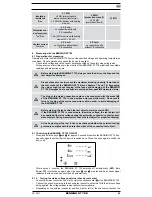
02/ 2011
BENNING ST 720
26
placed onto an insulated surface. Otherwise, leakage currents to earth might influence the
measuring result.
8.2.2 Testing of devices of protection class II
(shock-proof) and of devices of protec-
tion class III
(safety extra-low voltage)
Testing of devices without protective conductor and with accessible conductive parts
- Connect the test object to the test socket
1
of the BENNING ST 720.
- Establish a connection between the 4 mm test socket
9
and a metal part of the test object
by means of the test lead with alligator clip.
- For mains operating mode (contact current by means of the direct measurement method,
test object in operation!): Connect the plug of the mains connection cable with the socket
K
and the shock-proof plug with a protected shock-proof socket (230 V, 50 Hz, 16 A).
- If necessary, the testing voltage of the R
ISO
(insulating resistance) measurement can be
reduced to 250 V
DC
by means of the
-key
5
. The selected testing voltage is briefly shown
on the display
8
. Press the key again to switch back to the preset testing voltage of 500 V
DC
.
- Switch the test object on.
- Press the
key
3
to start the automatic testing procedure.
- If "Lo LOAD" is shown on the display, please check whether the test object is switched on.
- Press the key
3
to continue the testing procedure in case of the load being too low (R
L-N
> 6 kΩ).
- If "HIGH LOAD“ is shown on the display, this indicates an excessive load (R
L-N
<< 14 Ω,
I
LAST
(I
LOAD
) > 16 A) of the test object. There might be danger of a short-circuit or of an earth
fault. Check whether there is a short-circuit between the external conductor (L) and neutral
conductor (N) of the test object.
- If there is no short-circuit, you can continue with the testing procedure by pressing the
-key
3
.
- If the insulating resistance R
ISO
is higher than the admissible limiting value, a
appears
next to the R
ISO
symbol.
BENNING ST 720 in mains operating mode:
- The BENNING ST 720 interrupts the testing procedure after the R
ISO
(insulating resistance)
measurement and requests the user to switch the mains voltage of 230 V to the test socket
1
by showing a flashing "I
LEAK
" symbol. - Make sure that the test sample is protected and
press the
-key
4
to measure the contact current I
LEAK
(direct measurement method).
- The contact current by means of the direct measurement method only starts as soon as the
mains voltage is correct applied.
step 1 of 2:
- After a measuring time of 5 seconds or by pressing the key
4
, mains polarity will be re-
versed and the contact current will be measured with reversed mains voltage ("L/N" - "N/L").
The highest measured value of both measurements will be displayed. (step 2 of 2)







































